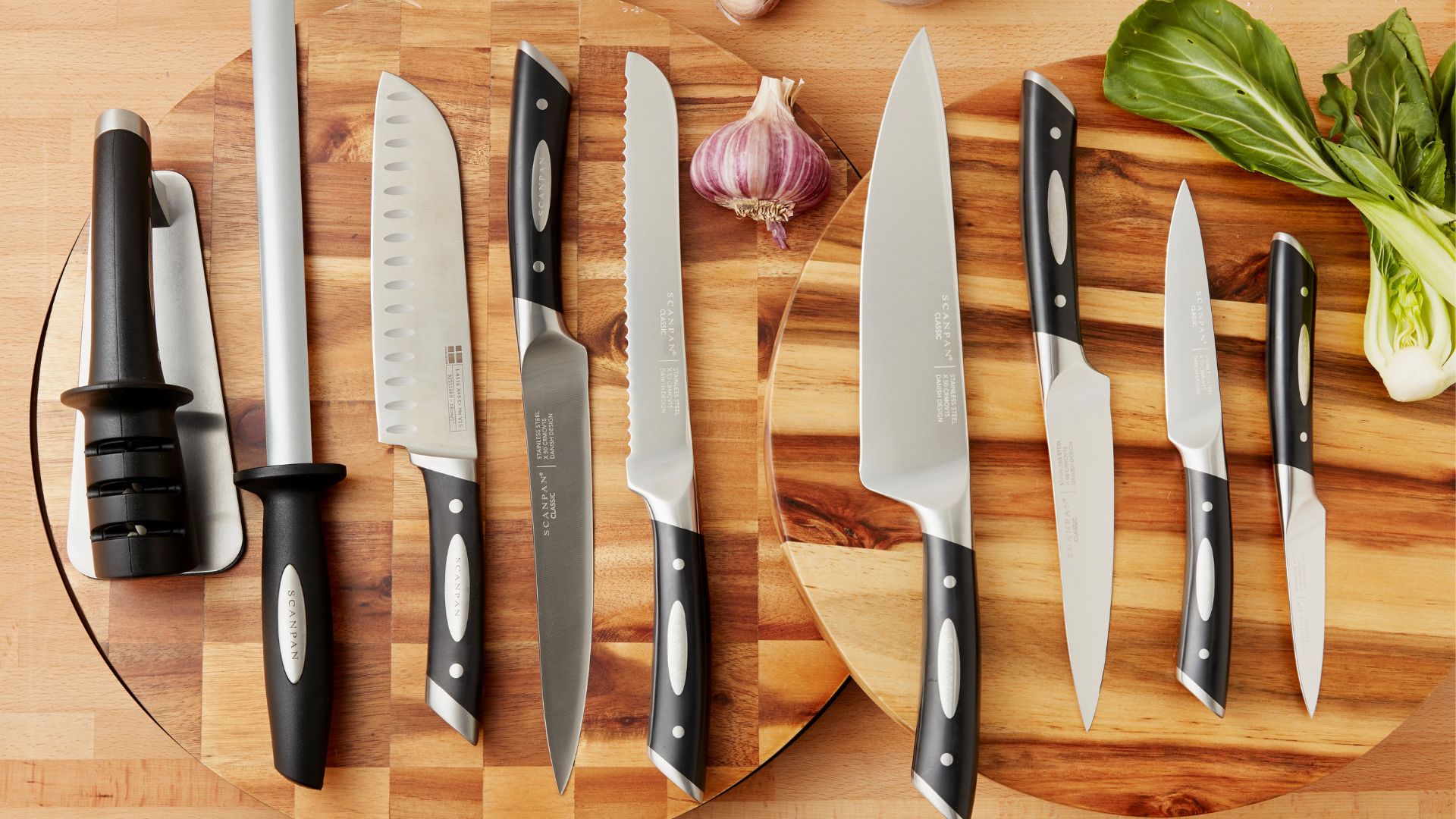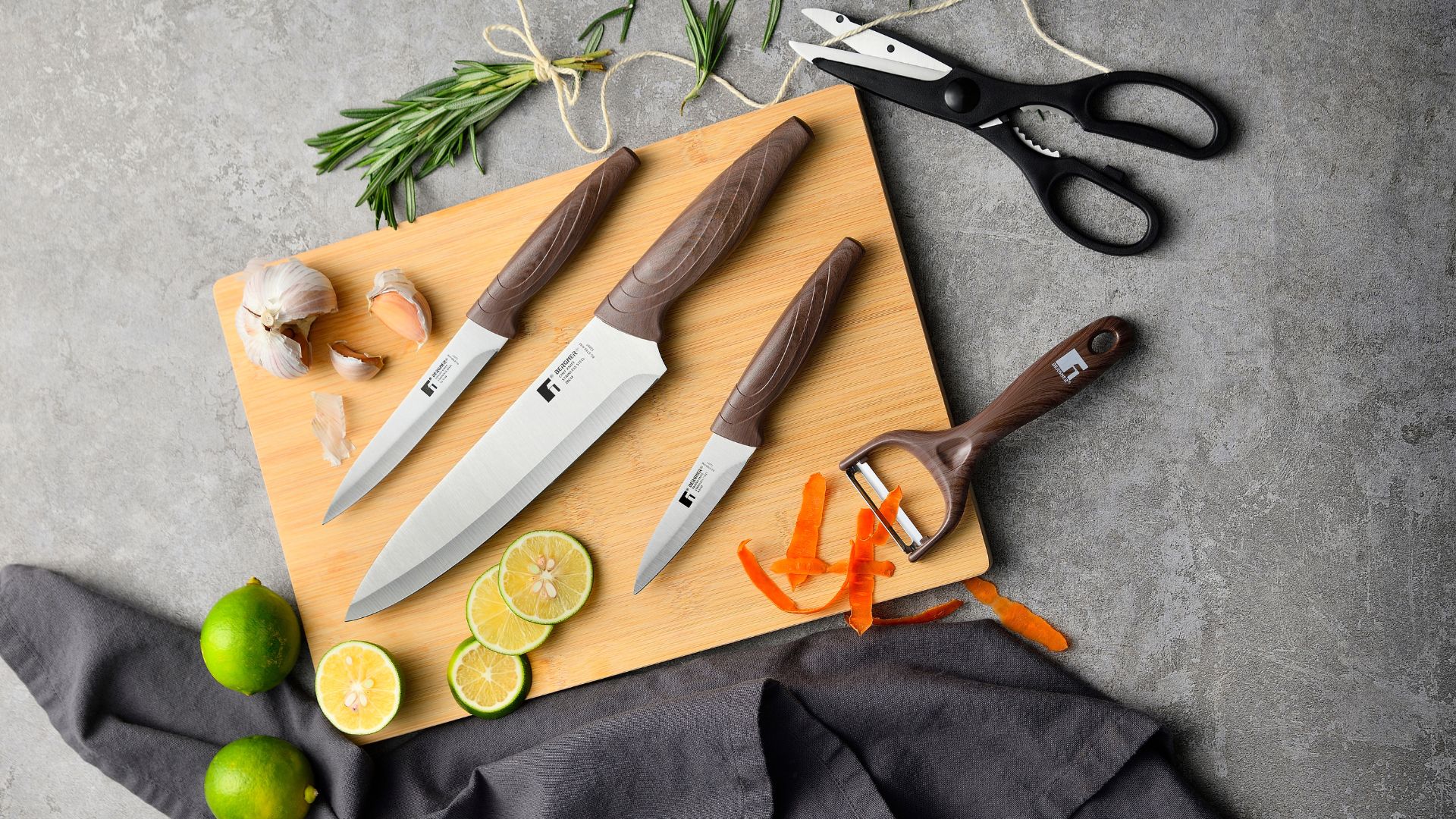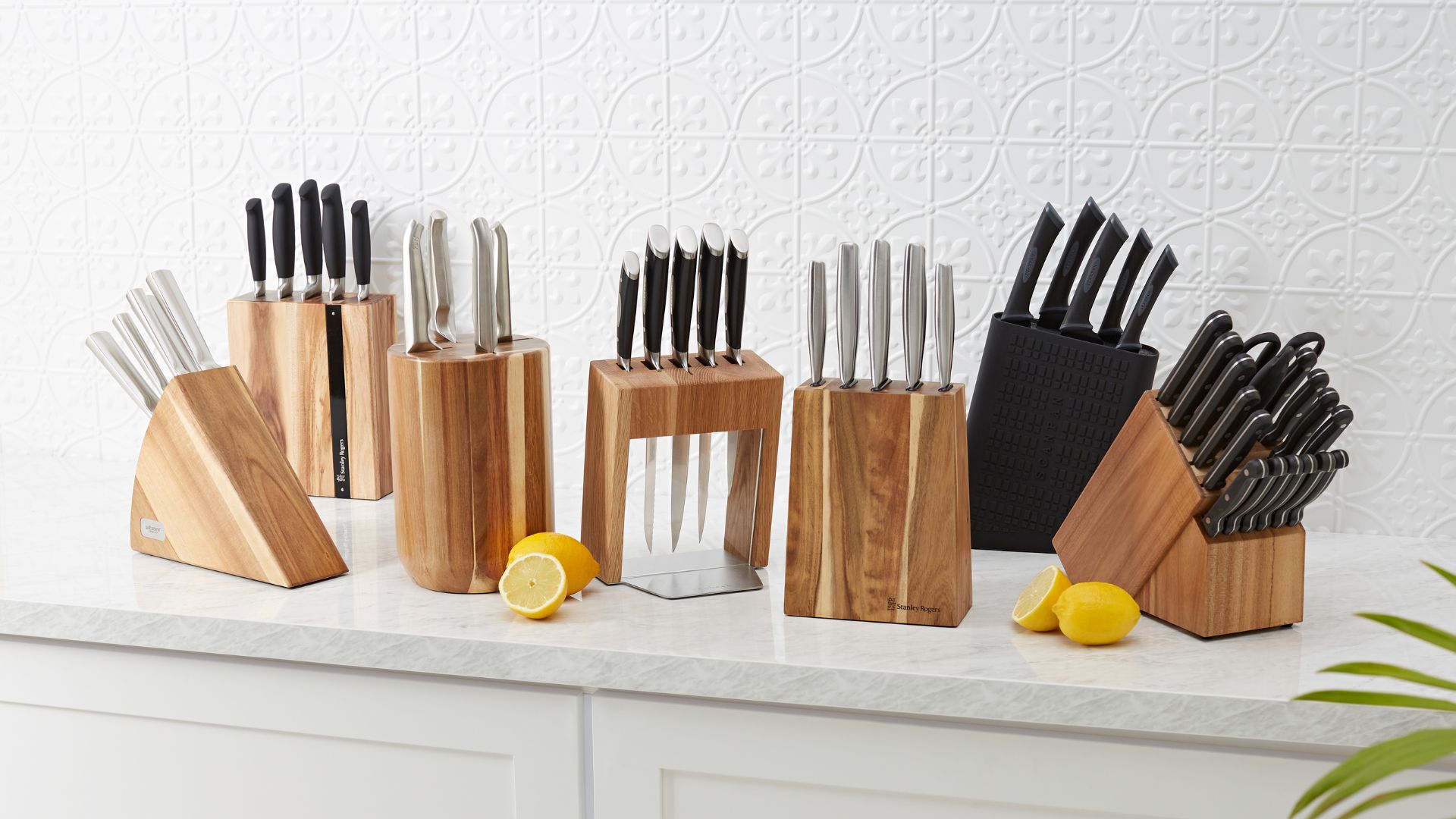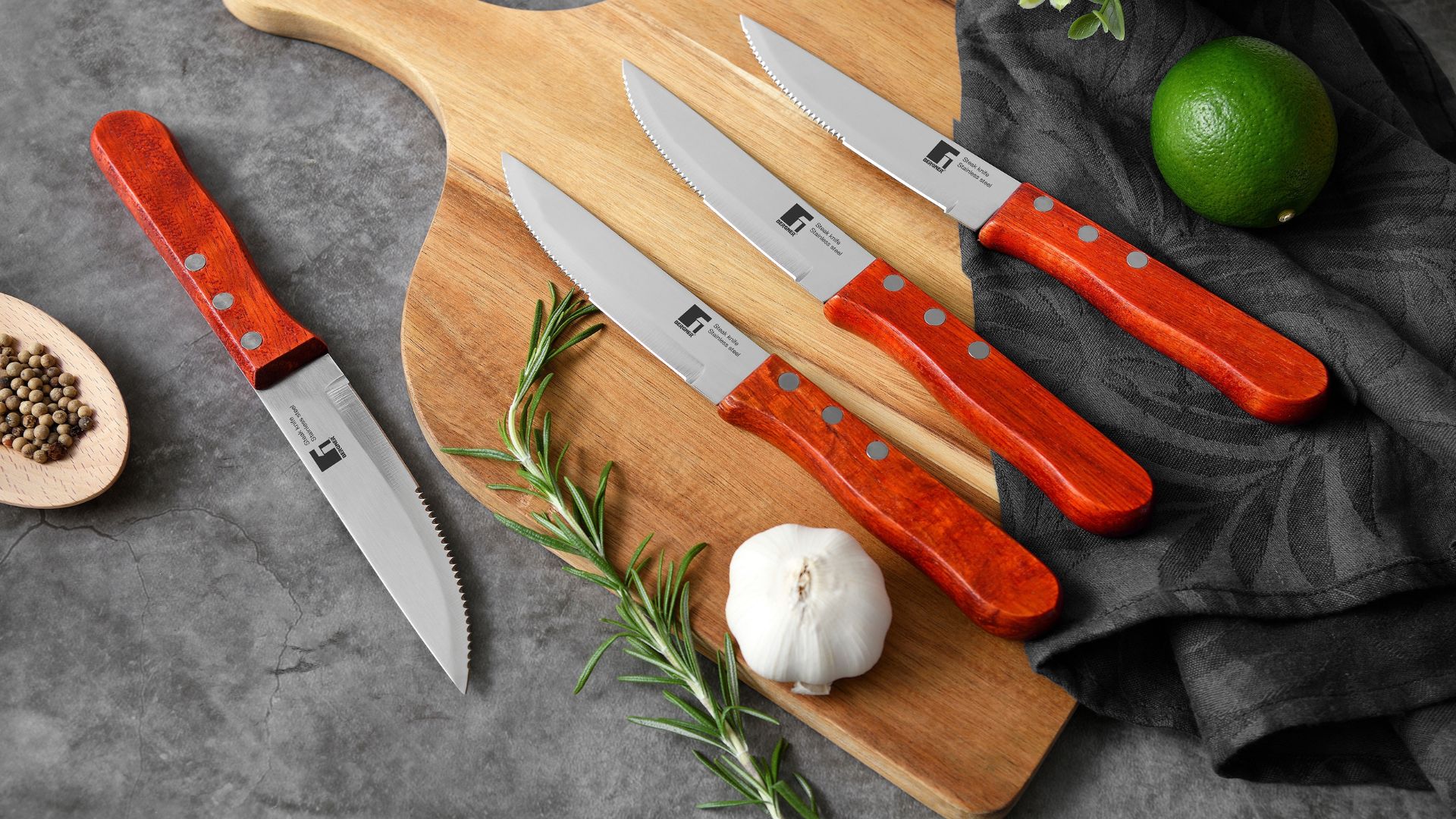| Your browser is not supported. | ||
|
Please browse our site using any of the following options:
| ||
Everything You Need To Know About Kitchen Knives

A cook's best friend and an essential piece of kitchen equipment - knives are indispensable for meal prep. But, with all the different types of knives in the kitchen, often it can be hard to tell one from the other or have clarity on their purpose. You may also be wondering about questions like, what is a chef's knife? Or what is a paring knife used for? We've put together this guide to understand better the different knife types and how to best use them. After all, knowing what to use and where can open up a new world of possibilities in the kitchen. So, let's get started.
Quick Links
- Frequently Asked Questions
- Common Types of Knives
- The Best Knives for Preparing Meat
- The Best Knives for Fish
- The Best Vegetable Knives
- Types of Cutlery Knives
- The Best Knife Blade Material to Invest In
- Choosing the Best Types of Kitchen Knives for your Home
Frequently Asked Questions
What are the three most common knives used?
A chef's knife, a paring knife and a serrated knife are the most common types of kitchen knives. Wondering about the use of a paring knife or the advantages of a chef's knife? We've outlined these in detail below in the guide.
What does a tang add to a knife?
The knife tang is the bottom section of a knife blade that connects to the handle. This makes the tang the knife's backbone, as it successfully holds the whole tool together. A full tang extends to the knife's handle, giving the handler more leverage and balance. A partial tang, on the other hand, where the tang does not cover the entire handle, contributes to a lighter handle.
Common types of knives

For those with knife paralysis, this guide unpacks the types of knives, especially the most common ones you'll come across and need.
Chef's knife
This classic and versatile knife is also one of the most common types of knives in the kitchen. This jack-of-all-trades knife is characterised by a broad blade tapering upward, leading to a pointed edge. The construction makes it easy to rock it back and forth while cutting or mincing. Typically, the chef's knife blade is between 6-12 inches long and is a size to pick based on the cook's hand size. As the most hard-working knife in your knife arsenal, you'll see that it's been designed to offer better grip and support - with the blade extending to the whole length and width of the handle.
What is a chef's knife used for?
Make a chef's knife your go-to for chopping and dicing vegetables, fruit and herbs. Avoid using it to carve cooked meat.
Santoku Knife
Akin to a chef's knife, Santoku knives are versatile, with a straight blade and minor indentations. A Japanese rendition of the Western chef's knife - the Santoku's design is slightly shorter and thinner, favoured over the former for those who prefer a smaller and lighter blade. Santoku translates to 'three virtues' indicative of slicing, dicing and mincing. Since the blade is flat, it lends itself easily to an up-and-down chopping motion.
What is a Santoku knife used for?
Like the chef's knife, Santoku knives are great for chopping and dicing vegetables, mincing meat and slicing cheese. This all-rounder type of knife in the kitchen is also perfect for skinny vegetable slices. Thanks to the little indentations along the blade, it's easy to cut through meat, fish or other materials without the food sticking to it and affecting the cut.
Serrated Knife
Also known as a bread knife, this type of knife is ideal when cutting both hard and soft food types. A serrated knife has small grooved blades, which lend the knife both sharpness and longevity. These types of knives measure between 6-10 inches.
What is a serrated knife used for?
As the name suggests, a bread knife is perfect to saw through crusty bread or tomatoes. Think baguettes, bagels and bread rolls. The serrated edges keep your fluffy loaves looking flawless, without losing their shape, even after cutting through that first slice.
Utility Knife
Another kitchen all-rounder is the utility knife. With a size range of 4-7 inches, the utility knife is a great starting knife for every home cook. They are particularly effective when working on smaller food items, ensuring more precision cutting work. On the downside, it lacks the chopping prowess of a larger chef's knife.
What is a utility knife used for?
The utility knife makes its mark by quickly cutting food that's too small for a chef's knife. So, what's the use of a utility knife, you ask? Think thin slices, trims, and fillets. Use it for smaller food and vegetables like shallots. Avoid slicing larger items with this knife.The best knives for meat preparation

Whether you're thinking of significant beef cuts or delicate lamb joints - meat preparation needs specialist kitchen tools. From a boning knife to a cleaver, we'll decode some of the different types of knives in the kitchen.
Carving knife
Carving or slicing knives get their name from cutting thin slices of meat off the large turkey, ham, lamb and beef roasts. Longer than most knives and with a slimmer blade, carving uniform pieces of meat is an absolute dream with this knife. The blade has a length of 8-12 inches, offering flexibility with long and precise cuts. The thin blades of the carving knife also make it ideal for cutting cakes - creating slices in one smooth motion.
Butcher knife or cleaver
A cleaver or butcher knife comes with a broad and heavy blade, a full tang and a thick spine - making it perfect for beating and chopping raw meat through the bone. The wide blade lends weight and heft, allowing chefs to drop the knife and cut without tiring the wrist or hand. Butcher knives are also some of the broadest and heaviest, available in various sizes. Depending on the country of origin, cleavers offer different degrees of curvature. Chinese cleavers, for instance, feature a straight blade, while German choppers have a more defined curve.
Pro tip
Use the flat and heavy side of the cleaver to crush garlic cloves or ginger.
Boning knife
Don't be fooled by the size of a boning knife. Smaller in appearance, a boning knife is possibly one of the most potent types of kitchen knives in your toolkit. As the name suggests, you can conveniently remove and separate meat from the bone using this knife. With a typical length spanning 3-8 inches, boning knives come with varying blade widths, offering a combination of flexible, semi-flexible, or stiff blades. The rigid blades are particularly popular with home chefs due to the promise of enhanced precision while cutting. This handy kitchen tool debones meat efficiently, also reducing wastage. Knives are typically lightweight and easy to manoeuvre, offering comfort and ease of use.
Pro tip
Remember to cut around the bone and not through.The best knives for fish

Whether you're descaling, filleting, slicing, dicing or removing bones from fish - a task-appropriate knife is key to simplifying the process. We explore some of the names of knives that you can use.
Filet knife
You're not alone if you find raw fish demanding and challenging to cut. After all, we've all been guilty of using the wrong type of knife, only to damage the piece of fish and make it incredibly hard to cook. A filet knife is an answer if you're struggling to cut precisely.
Featuring a thin, sharp blade with razor-sharp curves, a filet knife makes it easy to carve fish, offering precision cuts. If you want to break down a whole fish into parts or trim the bones, a filet knife can help you do it all. Blades typically range from 6-11 inches and are flexible, allowing you to slide under the skin and separate the skin from the flesh.
Pro tip
Opt for a stainless steel knife as these offer corrosion resistance, an essential requirement since your blades will constantly be in and out of water.
Salmon Knife
Slice, fillet, and remove the skin from salmon and similar large fish with the salmon knife. Sporting long, flexible, double-edged blades, it's easy to slice and create neat fillets without damaging the fish. Salmon knives come with indentations along the blade's sides to reduce drag and ensure the raw fish doesn't stick to the metal.
The best knives for cutting and chopping vegetables
While it's a widespread practice to use a chef's knife to slice, chop and dice vegetables for everyday cooking, if you're looking to take your skills up a notch - have a read of our top recommendations of different knife types for vegetables. Let's dive in.
Nakiri Bocho
This Japanese-style knife is explicitly designed for cutting vegetables. The blade is long, straight, and wide with squared-off edges. With this design style, it's easy to cut long veggies, like eggplants and carrots, in half, in a single chopping motion. Alternatively, suppose you're looking to make thin slices of cucumber or tomatoes. In that case, the Nakiri Bocho is the knife to use.
Pro tip
The deep flat design of the blade also makes it easy to shred larger vegetables like cabbage or lettuce. Use the thin and sharp edges for fine, thin slices.
Paring knife
Also known as a peeling knife, a paring knife is ideal for peeling various fruits and vegetables. Short and rigid with a slightly curved blade - a straight and highly sharp edge characterises this knife. The ergonomic handles ensure a firm but a comfortable grip, making it much safer to use.
Use of paring knife
This short knife comes with a blade that's 3-4 inches long. Its compact size makes cutting, trimming, and slicing relatively more straightforward and precise. So what is a paring knife used for?
- Peeling
- Slicing
- Seed removing
- Eyeing potatoes
- Crushing garlic
- Skinning mushrooms
- Chopping herbs
Types of cutlery knives
The dinner knife is a standard dining table staple, used through breakfast, lunch and dinner every day of the week. Composed of stainless steel, knives come with slightly serrated edges to cut more challenging foods like meat. Here are some of the popular types of dinner knives.
Steak knife
This table knife comes with sharp pointed tips and serrated edges. With this type of knife, you'll be able to cut into cooked meat like steak easily. Keep this sharp and versatile knife handy if you or your family indulges in meat during meal times.
Butter knife
In sharp contrast to the steak knife, the butter knife has a soft and blunt edge with a broad shape that makes it easy to slather butter or jam on a bread slice without scraping up crumbs. Butter scones, English muffins or sandwiches without breaking into a sweat. Again a must-have in your kitchen arsenal.
The best knife blade material to invest in
The material you choose for your knife will determine its longevity, performance and resistance to rust and corrosion. Different types of knives are available in different materials, each with distinct benefits and drawbacks. Before investing in kitchen knives, here's a little lowdown on different material types.
Carbon steel
Created by combining carbon with steel, carbon steel knives feel harder and are easy to sharpen than ordinary steel. It's also easy to forge carbon steel into a thinner blade, and many chefs swear by their sharpness. The downside is that carbon steel is highly vulnerable to rusting and staining - making the knife maintenance-intensive if you want to improve longevity.
Stainless steel
Arguably one of the most popular knives, stainless steel offers excellent corrosion and rust resistance. An alloy of carbon, iron and chromium - the chromium content in a knife affects its ability to be stainless and boast a shiny finish. The more chromium, the more stain-resistant your knife will be. Furthermore, stainless steel makes for an excellent option for the home cook who doesn't want to spend too much time on upkeep. Blades are thicker than carbon steel and are not as sensitive to acids from lemons, tomatoes, onions, etc.
Titanium
This rust-resistant material is distinguishable by its dark silver colour. This is presumably one of the world's hardest materials and is highly resistant to rust, making it an excellent material for designing pocket blades and diving knives. The only downside is that these blades tend to be softer and not as sharp - making them a not-so-ideal choice for kitchens.
What other kitchen tools and accessories should you invest in with knives?
We highly recommend a good set of kitchen shears when cutting parchment paper, pastry dough, or butchering chicken and pan-dressing a whole fish. Many kitchen shears come with bottle-opening features and other handy tools - making them a must-have in your kitchen.
Choosing the best types of kitchen knives for your home
With our exhaustive guide, it's easy to pick and choose the best types of kitchen knives based on the task at hand. Our online Home Hub offers more inspiration for making your time in the kitchen productive and hassle-free.